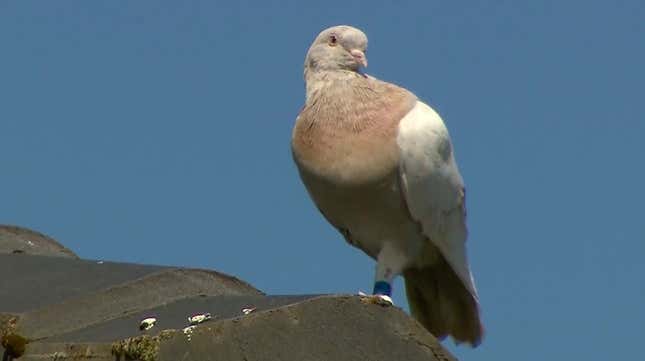
Update 1/15/2021 8:50 a.m. ET: Good news for “Joe” the pigeon. According to the AP, the bird is in fact Australian, and thus does not need to be killed. Deone Roberts, spokesperson for the American Racing Pigeon Union, told the AP that the leg band that identified Joe as American is “counterfeit.” Australia’s Agriculture Department told the AP, “Joe the Pigeon is highly likely to be Australian and does not present a biosecurity risk.” Original article appears below.
Officials in Australia are worried that a racing pigeon, which recently completed an 8,000-mile trek from the United States, carries potentially dangerous diseases. This unintentional breach of Australia’s quarantine laws could now cost the bird its life.
Melbourne resident and appropriately named Kevin Celli-Bird found the pigeon, emaciated and exhausted, in his backyard on December 26, reports the Associated Press. The bird went missing on October 29 during a race being held in the state of Oregon. Clearly, the racing pigeon—which somehow made a miraculous 8,100-mile (13,100-km) journey to Australia—veered way off course.

After drinking some water and taking a bath in Celli-Bird’s backyard fountain (and also being fed some biscuits), the pigeon decided to stick around. Celli-Bird, who named the bird “Joe” in honor of the U.S. president-elect, decided to capture it after noticing a blue band on its leg.
Realizing he had a racing pigeon on his hands, Celli-Bird contacted a local pigeon club, but it wasn’t listed in their records.
“I Googled it and it showed up an American racing pigeon union and it was registered to someone in Montgomery, Alabama,” Celli-Bird told 7NEWS in Australia.
He has been unable to reach the owners.
The Australian Quarantine and Inspection Service (AQIS) is aware of the situation and very unhappy about it. Officials with the department asked Celli-Bird to capture the pigeon for fear that it’s carrying diseases not found in Australia. Joe is “not permitted to remain in Australia,” according to a department statement, because the bird “could compromise Australia’s food security and our wild bird populations.” Consequently, the wayward bird presents a “direct biosecurity risk to Australian bird life and our poultry industry,” per the AQIS statement.
AQIS contacted Celli-Bird and asked him to capture Joe, but the pigeon is healthier now and not so easy to subdue.
“They say if it is from America, then they’re concerned about bird diseases,” he told AP. “They wanted to know if I could help them out. I said, ‘To be honest, I can’t catch it. I can get within [a few inches] of it and then it moves.’”
The department will now hire a professional to apprehend the rogue bird (no word if this professional goes by the name of Ace Ventura) and then destroy it, presumably in a humane manner. Indeed, AQIS doesn’t mess around; in 2015, the department threatened to kill a pair of Yorkshire terriers smuggled into the country by actor Johnny Depp and then-wife Amber Heard (the dogs, named Pistol and Boo, were sent back to the U.S.).
So this is obviously a really intriguing story, but I also want to know how this bird actually made it from Oregon to Melbourne. Pigeons aren’t known for epic trips over water, which are typically reserved for birds like bar-tailed godwits.
Last year, for example, a bar-tailed godwit made a record nonstop flight from Alaska to New Zealand, a 7,987-mile (12,854-km) journey that lasted 11 days. These birds have special adaptations that make such treks possible, such as low metabolisms and the ability to sleep while flying. Racing pigeons, on the other hand, don’t have these same abilities.
That said, racing pigeons are capable of long-distance flights, as races can involve distances between 62 and 310 miles (100-500 km). Racing pigeons cannot perform these extreme flights nonstop, requiring them to land from time to time.
Joe, unlike the record-breaking bar-tailed godwit, wasn’t tracked with a satellite tag, so we’ll likely never know how it made the journey across the Pacific. But as Brad Turner, secretary for the Australian National Pigeon Association, told AP, some racing pigeons from China make the trek to Australia aboard cargo ships. Something very similar may have happened here, allowing Joe to reach the Australian west coast.